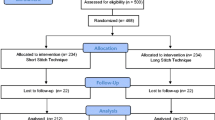Summary
The burst abdomen has been a constantly present complication in the last century. A collective review of the literature showed that predisposing, contributing, and causative factors have all been recognized early in the last century. The incidence of abdominal wound dehiscence has not changed appreciably. In a retrospective clinical study the incidence of wound disruption after 2030 median laparotomies was 1.3%. Inadequate knot and suture technique were causative, and layered closure needed revision. In an experimental study using rats, the healing of a midline defect of the abdominal wall was strengthened only by the addition of retention sutures, not by the use of supporting devices. In a prospective clinical study the abdominal wound was closed in one layer with large bites (> 1 cm) and with small steps (< 1 cm) of continuous PDS. Fifteen wound disruptions occurred (0.6%) after closure of 2488 median laparotomies. Scrutiny of the disrupted wounds revealed non-compliance with the suture protocol in the vast majority of cases. The surgeon is a prognostic factor in abdominal wound closure. Nothing has changed in 100 years.
Similar content being viewed by others
References
Abel (1898) Über Bauchnaht und Bauchnarbenbrüche. Arch Gyn 56
van Geldere D (1986) De gebarsten buik (The burst abdomen). Academic Thesis. Amsterdam: University of Amsterdam
Hodgson NCF, Malthaner RA, Ostbye T (2000) The search for an ideal method of abdominal fascial closure. Ann Surg 231: 436–442
Jenkins TPN (1976) The burst abdominal wound: a mechanical approach. Br J Surg 63: 873–876
Madelung (1905) Über den postoperativen Vorfall von Baucheingeweiden. Verb Dtsch Ges Chir
Maingot R (1957) Management of abdominal operations. 2nd ed. London, Lewis
Niggebrugge AHP, Trimbos JB, Hermans J, Steup WH, van de Velde CJH (1999) Influence of abdominal wound closure technique on complications after surgery. Lancet 353: 1563–1567
Norris JD (1939) A review of wound healing and the mechanics of dehiscence. Surgery 5: 775–786
Weiland DE, Bay C, Del Sordi S (1998) Choosing the best abdominal closure by meta-analysis. Am J Surg 176: 666–670
Wissing J, van Vroonhoven Th JMV, Eeftinck Schattenkerk M, Veen HF, Ponsen RJG, Jeekel J (1987) Fascia closure after midline laparotomy: results of a randomized trial. Br J Surg 74: 738–741
Author information
Authors and Affiliations
Corresponding author
Rights and permissions
About this article
Cite this article
van Geldere, D. One hundred years of abdominal wound dehiscence and nothing has changed. Hernia 4, 302–304 (2000). https://doi.org/10.1007/BF01201090
Received:
Accepted:
Issue Date:
DOI: https://doi.org/10.1007/BF01201090




